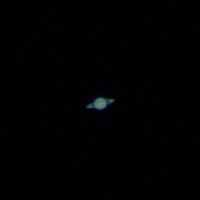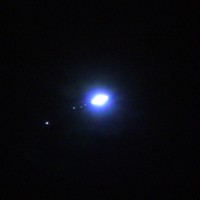Magnificent Saturn
March 2008 :
Note: This article may contain outdated information
This article was published in the March 2008 issue of The Skyscraper and likely contains some information that was pertinent only for that month. It is being provided here for historical reference only.
While one can find many images of Saturn and his moons on the internet, there’s nothing like experiencing this magnificent planet firsthand by observing through your own backyard telescope or those at Seagrave Observatory in North Scituate or Ladd Observatory in Providence.
If you want to observe Saturn on your own, you first need to know where to locate the ringed world in the sky. From now until Saturn is lost in the Sun’s glare sometime during mid July, the planet can be found within the constellation Leo the Lion. (You’ll lose sight of Saturn much earlier if you don’t have a dead horizon.) In fact, Leo’s bright and bluish-white star Regulus can be used as a guide to finding Saturn throughout this entire period.
Regulus is at the bottom of the “sickle-shaped” star pattern that marks the head and front quarters of the lion (this asterism also looks like a backwards question mark, with Regulus in the location of the period). At the beginning of March look towards the east southeast and about halfway up off the horizon to locate Leo and Saturn. See accompanying star map.
“There is probably no single telescopic view that can compare to the power to excite wonder with that of Saturn when the ring system is not so widely opened but that both poles of the planet project beyond it. One returns to it again and again with unflagging interest, and the beauty of the spectacle quite matches its singularity.” (Garrett P. Serviss in his 1901 book, Pleasures of the Telescope.
Today, with even a small, inexpensive telescope, the causal astronomy enthusiast can catch a glimpse of Saturn and his rings. Keep in mind when Galileo Galilei first observed Saturn in July 1610 with his telescope having a one-inch diameter lens providing a magnification of 30 times, he was unable to resolve the rings. He observed what he believed to be two moons on either side of Saturn’s disk (it looked like Saturn had ears or handles), which didn’t change position like Jupiter’s moons did. He soon lost interest.
When he next visited Saturn the moons were gone! This event was something Galileo could not explain, and he died before the true nature of his observation was discovered.
As Saturn revolves around the Sun in his 29.5 year orbit, the angle of the rings varies by just over 27 degrees relative to the Sun. So, approximately every 15 years the Earth passes above or below Saturn’s ring plane. Right now earthly stargazers are looking at the southern face of the rings. But that tilt is changing.
Over the next few months you can watch as the rings begin to “close-up.” Until May the rings actually open up a little, but thereafter they begin to close. Unfortunately when the rings are edge-on, September 4, 2009, we will not be able to see the event from Earth. In fact, earthbound astronomers do not get a favorable ring crossing event until 2038.
When this event can be seen from the Earth, the rings practically disappear when viewed through smaller telescopes. Larger telescopes reveal a very thin and tenuous line in the plane of Saturn’s equator.
Well, as fate would have it, when Galileo revisited Saturn the Earth was crossing the ring-plane and the rings (Galileo’s two moons) disappeared.
It’s amazing Saturn’s rings are visible at all, considering the planet’s distance from the Earth, and the fact that the ring plane is only about 328 feet thick (just larger than the length of a football field). Although there are hundreds of ringlets, you shouldn't have any difficulty seeing the separation between the primary “A” (outer) and “B” (inner) rings, called the Cassini Division. This gap is only 2,175 miles wide. In comparison, the width of the “A” ring is 9,321 miles and the “B” ring is around 16,032 miles across.
The rings are comprised of irregularly shaped dirty snowballs, ranging in size from grains of dust to many particles the size of pebbles. There are also some "boulders" as large as a few hundred feet and some small mountain sized bodies. They all orbit Saturn along the planet's equatorial plane.
When and if you ever tire of observing Saturn’s magnificent ring system, turn your attention to the planet’s salmon-colored cloud tops. The bands in its upper atmosphere are much less prominent than those of Jupiter. Very little cloud detail can be seen in small telescopes. Saturn would look very boring if it weren’t for its ring system. One thing you can look for though, is the shadow of the planet projected onto its rings.
At last count Saturn had about 61 moons! Only a handful can be visually observed with the telescopes available locally. Its four brightest are Titan, Rhea, Dione and Tethys, and you can watch these moons orbit Saturn like a solar system in miniature. Titan, which orbits Saturn in 16 days, will be the brightest and, during its greatest elongations east or west of Saturn, can be easily spotted. The next four in order of decreasing brightness are Iapetus, Enceladus, Mimas and Hyperion, which can all be spotted with moderately sized instruments.
Enjoy the beauty of this magnificently ringed world almost one billion miles from our home planet.
If you don’t own your own telescope, or the view through the one you do own is too small to see much detail, plan on visiting Seagrave Observatory (http:/www.theskyscrapers.org) on Peeptoad Road in North Scituate on any clear Saturday night (7-10pm).
You can also visit Ladd Observatory
(http://www.physics.brown.edu/physics/commonpages/ladd/) located on Hope Street on Providence’s East Side on any clear Tuesday night (7-9pm).
Both web sites provide directions and weather closure information.
As always, keep your eyes to the skies.





